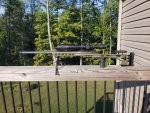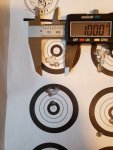I use increments that correspond to 1% or so of the overall starting load weight (i.e. 42gr, .4gr increments). I start at the high end (for me, max charge minus 2%) and work my way down. I make 12 rounds of each load, and shoot two groups of five rounds each, throwing out called flyers and shooting the extra round(s) to take their place. Trying to shoot more than ten increments per session is unproductive since it encourages fatigue and rushing the process. When you find a tight charge/group coincidence, return next session with charges that bracket the good ones by .5% increments (i.e. 42gr, .2gr increments). ...And yes, my club range is also an hour distant.
At the end of each session, I shoot one aggregate group consisting of all the unfired rounds, it should create a group that looks like stringing. If not, there may be a mechanical issue regarding the bedding/scope mounting, etc.
Remove all fluky problems from the system before shooting the groups; i.e. eliminate parallax, verify guard screw torque, etc. Without this step, random errors become more likely.
I avoid cleaning during load testing, to remove yet another variable. You should be able to shoot several hundred rounds before cleaning becomes an imperative.
Start each session by shooting a couple of groups with a known good load, this calibrates the shooter and also adequately fouls the barrel.
Maintain a steady firing cadence that does not vary between increments.
Never adopt a load that has not been confirmed with at least 5 acceptable groups.
Load development ultimately reaches a point of diminishing returns, stop before it seriously impacts bore life. If I get 1/2MOA out of my testing, I'm better than good. It begins with arbitrary values for seating depth/jump, I usually start and stay at magazine feeding length. Primer testing and seating depth variations are done after a good ballpark load weight is established. Once all the variables are found, try bracketing the charge weight again by .5%, to see if that refines the load any further.
Final, and probably the most important suggestion; never attempt to change more than one factor, like charge weight, or primer brand, etc., in any single session. When more than one good charge weight is found within the reasonable weight spread, I prefer choosing the lower one to reduce bore wear. High speed equaling good accuracy tends to be a myth, all velocities demand proper winds skills. The less velocity, the longer the barrel will live, so perk up the wind skills rather than the velocity.
I have found that numbers like SD, etc., may or may not correspond to good accuracy. I only chronograph the final load (if at all), to plot trajectories with some accuracy. Fairly often, estimating velocity by combining judgement about loading manual info, altitude, and barrel length will deliver a muzzle velocity estimate that jibes pretty well against observed drops. Facts are, environmental variances will conspire to invalidate many calculations and assumptions, and just getting out there and shooting the rifle frequently will often serve one equally well.
Whatever else seems logically helpful.
Greg
Scientific Method.




